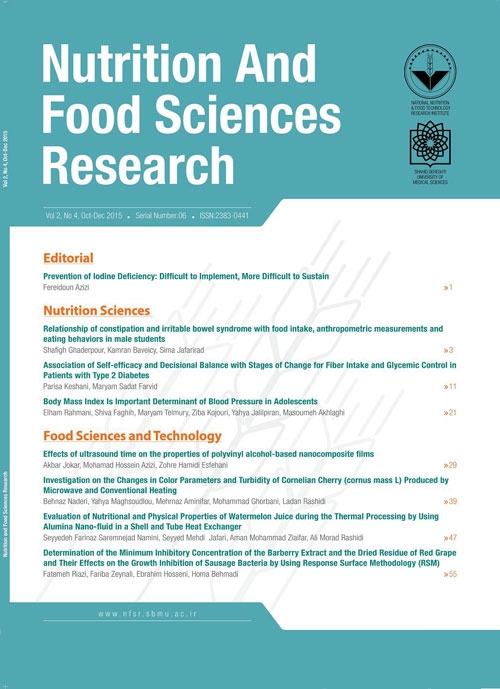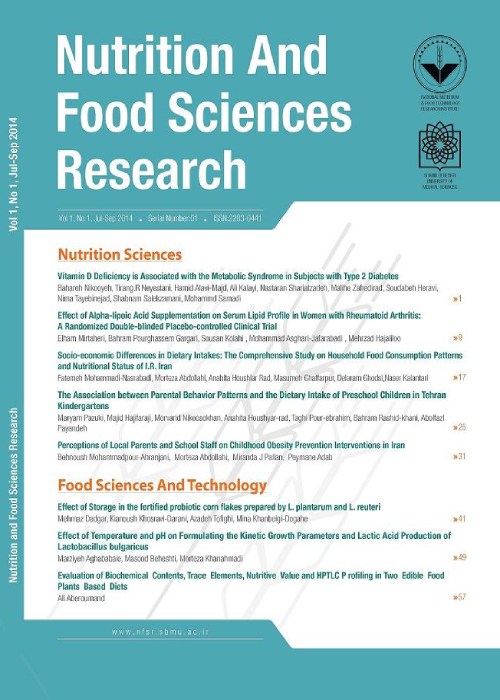فهرست مطالب

Nutrition & Food Technology Research
Volume:2 Issue: 4, Oct-Dec 2015
- تاریخ انتشار: 1394/07/23
- تعداد عناوین: 8
-
-
Pages 3-9Background And ObjectivesGastrointestinal disorders like irritable bowel syndrome (IBS) and constipation can affect the quality of life; and various factors play a role in these disorders. The aim of this study was to investigate the environmental factors related to these problems among Iranian male university students.Materials And MethodsThe study was conducted on 186 male students at Ahvaz Jundishapur University of Medical Sciences. Rome Criteria III (to identify gastrointestinal disorders), Dutch eating behavior, food pattern brief instrument and international physical activity questionnaires were completed by all participants; moreover, their anthropometric measurements were taken.ResultsThe results showed a significant difference in weight, body mass index (BMI), waist circumference, hip circumference, and waist to hip ratio in the students suffering from constipation compared with the healthy ones. The students with constipation had more significant milk intake and those with IBS had less intake of vegetables. No significant differences were observed in the eating behavior of students with constipation and IBS, and the healthy ones.ConclusionsWeight and other anthropometric indices could be considered as factors related to constipation. According to the results, an appropriate and balanced intake of different food groups with emphasis on vegetables, milk and dairy products could be recommended.Keywords: Irritable bowel syndrome (IBS), Constipation, Diet, Anthropometry
-
Pages 11-20Background And ObjectivesConstructs of behavioral models such as trans-theoretical model can be associated with healthy eating behaviors like increasing fiber intake. They can also be effective in improving these behaviors in patients with diabetes. This study aimed to assess the association of self-efficacy and decisional balance with stages of change for fiber intake and glycemic control in patients with type 2 diabetes.Materials And MethodsA cross-sectional study was conducted on 145 literate male and female patients with type 2 diabetes (aged 30 to 65 years); they were randomly selected from the patients’ list of “Charity Foundation for Special Diseases” and”Iranian Diabetes Society” in Tehran-Iran. Stages of change, self-efficacy, and decisional balance questionnaires were filled out, and three food records were used to assess their nutritional status. Blood samples were taken to assess fasting blood glucose, HbA1c, serum insulin, and insulin resistance. One-way ANOVA and logistic regression were used to analyze the data. The tests were done using the SPSS software (ver. 16). P<0.05 was considered significant.Results126 patients with type 2 diabetes completed the study. Participants’ mean age was 53.5±6.02 and 65% were men. Patients in post-action stages revealed higher self-efficacy than did those in pre-action stages (P=0.035). A relationship was observed between insulin resistance and self-efficacy (P=0.040). One unit increase in self-efficacy decreased the risk of insulin resistance by 12%, and each unit increase in decisional balance increased the chance of eating sufficient fiber by 2.2 times. There was also a significant relationship between the perceived cons (P<0.0001) and self-efficacy (P=0.037) with fiber intake after adjustment with confounders.ConclusionsThis study suggests that there is a relationship between transtheoretical model constructs such as self-efficacy and decisional balance, especially cons, with fiber intake in patients with type 2 diabetes. So it seems that considering these constructs in educational interventions could be effective in increasing the fiber intake in such population.Keywords: Dietary fiber_Type 2 diabetes_Decisional balance_Self_efficacy
-
Pages 21-28Background And ObjectiveObesity is an important risk factor for development of hypertension. We investigated the association between body mass index (BMI) and blood pressure in adolescents.MethodsThe cross-sectional study was performed on 694 adolescents aged 12-18 years from middle and high schools located in 4 districts of Shiraz, Iran. Height, weight, and systolic and diastolic blood pressures were measured according to standard procedures.ResultsThe prevalence of overweight/obesity and elevated systolic and diastolic blood pressure was 22.0%, 16.8%, and 13.3%, respectively. Compared to girls, boys had higher rates of overweight/obesity and elevated blood pressure. With increasing age, the prevalence of overweight decreased (20.6% in 15-18 years compared to 34.3% in 12-14 years) and that of elevated blood pressure increased (33.2% vs.14.6% for systolic and 22.2% vs. 10.3% for diastolic blood pressure) in boys whereas the prevalence of overweight/obesity and elevated blood pressure did not change among girls. In both sexes, elevated blood pressure had a positive association with BMI categories independent of age and this association was observed even in normal versus low BMI categories.ConclusionA strong association between BMI and elevated blood pressure advocates using strategies for the control of weight and prevention of obesity in adolescents.Keywords: Adolescents, body mass index, obesity, blood pressure
-
Pages 29-38Background And ObjectivesPreparation and evaluation of nanocomposite films have become prevalent in recent years. One of the most important methods for dispersing nanoparticles in polymers is the use of ultrasound radiation. Polyvinyl alcohol-montmorillonite (PVA-MMT) nanocomposite films were prepared via solvent casting method.Materials And MethodsThe effects of different ultrasound times (0, 10, 20, 30, and 40 min) on the properties of nanocomposite films were evaluated in a completely randomized design (CRD) with five treatments and three replicates. The films were characterized by mechanical properties, opacity, water vapor permeability (WVP), and color. Fourier transform infrared (FTIR) and X-ray diffraction (XRD) were applied to investigate and prove the effects of ultrasound time.ResultsResults revealed that the ultrasound time significantly affected the characteristics of the films. XRD and FTIR results were in accordance with the effects of sonication time. The changing trends of PVA film properties due to increasing the sonication times were not similar. Sonication time did not have any significant effect on some traits like a*, WVP, L*, and yellowness index (YI), while it affected b*, tensile strength, and opacity significantly.ConclusionsDepending on the target of using nanocomposite films, appropriate time of sonication should be used.Keywords: Ultrasound time, Polyvinyl alcohol, Nanocomposite film, Nanoclay, FTIR, X-ray
-
Pages 39-46Background And ObjectivesRed colored fruits such as cornelian cherry (Cornus mas L) are recognized as being healthy. The color of these fruits is an important sensory property in assessment of product quality; therefore, minimizing the loss of color in the process is very important.Materials And MethodsIn this study, comparison of the color, turbidity, degradation rate of anthocyanin, and rate of evaporation in cornelian cherry (cornus mass L) juice produced from microwave and conventional heating at different operational pressures (12, 38.5 and 100 K Pa) was investigated.ResultsThe final brix juice 42 AWT IMAGE was obtained in 137, 125, and 93 min by conventional heating at 100, 38.5 and 12 K Pa, respectively. Applying microwave energy decreased the required times to 115, 90 and 75 min at 100, 38.5 and 12 K Pa, respectively. In both methods, the heating temperature at pressures of 12, 38 and 100 K Pa was 50, 75 and 100 ° C, respectively. The results also showed that hunter lab values (L, a, and b) were decreased with increasing the time of process, turbidity, and degradation rate of anthocyanin.ConclusionsThe heating method affects the color, degradation rate of anthocyanins and evaporation rate of cornelian cherry concentrate. Also the results indicated that temperature and time of process are higher in conventional heating than in microwave. Degradation of anthocyanins and color of cornelian cherry juice was more evident in rotary evaporation as compared to microwave heating method. Thus according to the results, microwave energy could be successfully used in production of cornelian cherry juice concentrate.Keywords: Cornelian cherry, Heating method, Color, Anthocyanins
-
Pages 47-54Background And ObjectivesThermal processing is an effective method in preventing microbial spoilage but high heat transfer in a long time process that leads to quality loss and increased energy consumption. Also it is important to consider sensitive nature of food products during the thermal processing. Due to the nano-fluid's unique thermo–physical properties compared with the conventional fluids (steam and hot water), their use in various industries to enhance the efficiency of equipment and energy optimization has increased.Materials And MethodsThe effects of alumina–water nano-fluids (0, 2, and 4% concentrations) on some nutritional properties (lycopene and vitamin C content), and some physical properties (color, pH and TSS) of watermelon juice treated by high temperature–short time (75, 80, and 85°C for 15, 30, and 45 seconds) in a shell and tube heat exchanger were evaluated.ResultsIn compared with water, process time reduced by 24.88% and 51.63% for 2% and 4% nano-fluids, respectively. It had a significant effect on improving the properties of watermelon juice (P<0.05). Under the treatment conditions (75°C and 15s), with 0, 2, and 4% nano-fluids, 81.15, 84.81, and 91.28% of lycopene and 61.11, 63.70 and 67.04% of vitamin C were maintained, respectively. ΔE* values for the fruit juices processed with 0, 2 and 4% nano-fluids were 3.26, 2.21 and 1.14, respectively. Also pH and TSS changed in the range of 5.58–5.82 and 9.00–9.40%, respectively.ConclusionsThe results showed that qualitative and nutritional properties of watermelon juices processed with nano-fluids in terms of lycopene and vitamin C retention, and color were, respectively, 9.89, 6.18 and 50.38% better than the samples processed with water.Keywords: Color, Heat exchanger, Lycopene, Nano, fluids, Vitamin C, Watermelon juice
-
Pages 55-63Background And ObjectivesWith regard to the hazards of nitrite, application of natural preservatives in order to reduce the microbial load of meat and meat products is increasing. Owing to their anti-bacterial properties, red barberry and the dried residue of red grape could be suitable replacers for nitrite.Materials And MethodsAgar dilution method was employed in order to determine the minimum inhibitory concentration (MIC) of the barberry extract and the dried residue of red grape. The anti-microbial effects of the barberry extract (0-600 mg/kg), the dried residue of red grape (0-2%) and nitrite (30-90 mg/kg) were investigated on the total viable counts of Clostridium perfringens, as well as on the psychrophilic bacteria after 30 days of storage at 4°C. Finally, the effects of the three independent variables in the optimal sample were examined on the growth of the inoculated C. perfringens.ResultsThe MIC of the barberry extract and the dried residue of red grape on Staphylococcus aureus was 3 and 6 (mg/ml), respectively. In the case of Escherichia coli, it was 4 and 7 (mg/ml), respectively. The barberry extract and nitrite reduced the growth of the living aerobic bacteria significantly. The spores of the inoculated C. perfringens had no growth in the optimum sample during storage.ConclusionsThe barberry extract and the dried residue of red grape as natural preservatives, could partially substitute for nitrite in order to reduce the microbial load of sausage.Keywords: Barberry extract, Dried residue of red grape, Nitrite, Minimum inhibitory concentration, Sausage


